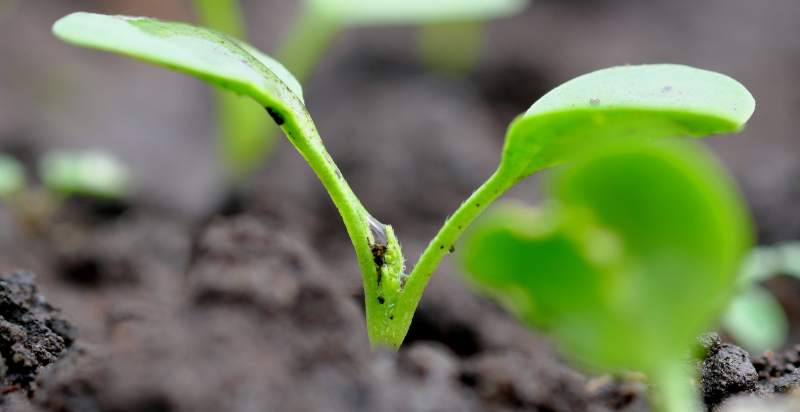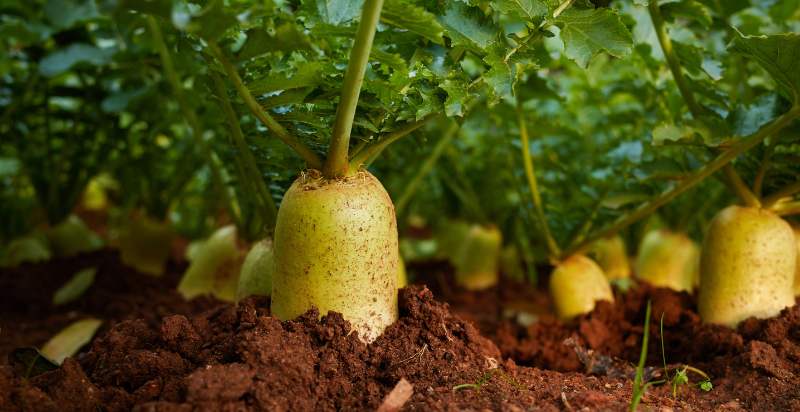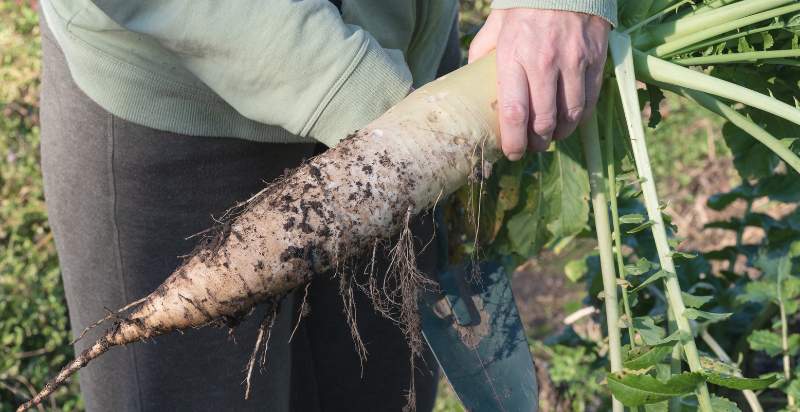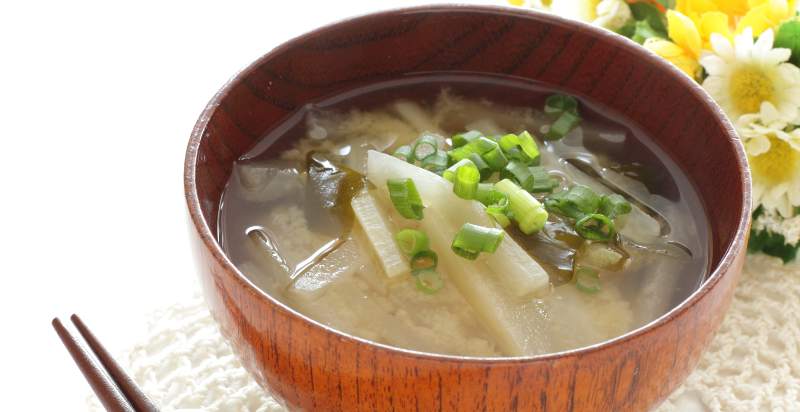Have you heard of daikon? Daikon is a type of radish grown in Asian cuisine with large, white roots that can be eaten raw or cooked. This root vegetable has a mild flavor and crunchy texture, making it the perfect addition to salads, stir-fries, soups, and salsas.
Not only does daikon have great potential for enjoyable culinary use, but it is also fairly easy to grow at home. With its short growing season—typically four to six weeks—this versatile crop will provide delicious results quickly.
This blog post will explore what makes daikon so extraordinary, from planting tips to harvesting advice. Ready to get your hands dirty? Let’s dive into all the fun details on how to plant, grow and harvest daikon root!
What is Daikon?
Daikon is a type of root vegetable belonging to the Brassica family. It is related to other vegetables, such as radishes and turnips. Daikon has a mild flavor that can be used in soups, salads, stir-fries, or pickled for added zest. The roots are long, white, and tapered, with an average length of 12 inches and a diameter of 1.5 to 3 inches.
Daikon is high in fiber and contains many essential vitamins and minerals, making it a healthy addition to your diet. It is also known for its health benefits, such as helping to reduce inflammation and improve digestion. Daikon can be eaten raw or cooked.
History and Origin of Daikon:
Daikon is thought to have originated in Japan, where it has been cultivated for centuries. It was first introduced to the United States during World War II when Japanese immigrants moved to the West Coast and brought their traditional vegetables with them. Daikon remains a popular vegetable in Asian cuisines, though it is also widely consumed in other parts of the world.
Types of Daikon:
There are two main types of daikon: the long, tapered white variety and the shorter, rounder red variety. The long white variety is also known as daikon radish or Japanese radish, the most common type found in grocery stores and Asian markets. The red variety is slightly spicy and is often used in salads or pickled.
Uses of Daikon:
Daikon is commonly used in soups, salads, and stir-fries. It can also be pickled, grilled, or roasted. Daikon is often used to add a mild flavor and crunchy texture to dishes. It is also used as a base for condiments like kimchi and takuan, which are popular in East Asian cuisine.
Nutritional Benefits of Daikon:
Daikon is low in calories but packed with nutrients. One cup (122 grams) of cooked daikon contains just 28 calories and provides 3 grams of dietary fiber, 12% of the daily recommended value. It’s also rich in many vitamins and minerals, including Vitamin C (14% DV), Vitamin B6 (10% DV), potassium (9% DV), magnesium (6% DV), and folate (5% DV).
Health Benefits of Daikon:
Daikon is an excellent source of dietary fiber, which helps to keep your digestive system regular. It’s also a good source of antioxidants, which can help protect your body from damage caused by free radicals. Additionally, daikon has anti-inflammatory properties that can help reduce inflammation in the body. Studies have also found that daikon can help lower blood pressure and reduce the risk of heart disease.
How to Plant Daikon?
Daikon, also known as Japanese radish, is a root vegetable widely used in Asia for centuries. It is nutritious and versatile, making it a great addition to many dishes. In recent years, daikon has become increasingly popular in the United States due to its health benefits and unique flavor.
Planting Daikon:
Daikon can be grown from seeds or transplants. If you are growing from seed, sow them a ¼-½ inch deep in rows about 12 inches apart after all danger of frost has passed and the soil temperature reaches 65°F (18°C). Plant seeds 1-2 inches apart in the row; thin out to 6-8 inch spacing when plants reach 2 inches in height. If planting from transplants, wait until after the last frost to set them out in the garden 6-8 inches apart.

Caring and Growing Daikon:
Daikon requires full sun and well-drained soil with a pH of 5.5–6.5. To ensure proper growth, water your plants evenly throughout the growing season, keeping the soil moist but not soggy; too much or too little water can cause poor growth and flavor.
Fertilize when seedlings first appear, again after a month or two, and then every 4–6 weeks. Mulching will help conserve moisture and keep weeds down in your garden bed. Daikon is susceptible to pests like aphids and Japanese beetles, so keep an eye out for them and take action if necessary.

Preventions from Pests and Diseases:
Daikon is susceptible to pests like aphids and Japanese beetles, so keep an eye out for them and take action if necessary. Additionally, daikon can be affected by common root diseases such as Fusarium wilt and Verticillium wilt. To prevent these diseases, rotate your crops yearly and avoid overhead watering.
Harvesting Daikon:
Daikon can be harvested when the roots are about 1-4 inches (2.5-10 cm) in diameter, depending on your preferred size; smaller varieties may only need a few weeks to reach maturity. Pull up the plants carefully with a garden fork or spade, as daikon has a deep taproot that can break easily if not handled properly. Enjoy fresh or store in the refrigerator once harvested.
Daikon is fairly easy to grow and adds great to any garden. With its unique flavor and many health benefits, it’s no wonder why it has become so popular. With a little care and attention, you can have delicious daikon in your garden all season long.

How to Store Homegrown Daikon?
Once harvested, daikon should be stored in the refrigerator to maintain freshness and flavor. For longer storage, up to one month, wrap the roots in paper towels, place them in a sealed container, and store them in the coldest part of your refrigerator. Daikon can also be frozen later; blanch cut or shredded daikon in boiling water for one minute, then cool and freeze. Enjoy your homegrown daikon year-round.
How to Use Daikon?
Daikon can be enjoyed in a variety of dishes. It is often grated or sliced and used raw in salads, pickles, and other condiments. It can also be cooked like any other root vegetable; try roasting, braising, or stir-frying daikon for a delicious side dish. Daikon is also used to make traditional Japanese dishes such as names (daikon and carrot salad) and kimchi.
No matter how you enjoy daikon, it will surely add flavor and nutrition to your meals!

Potential Risks from Daikon:
While daikon is generally safe to consume, there are a few potential risks to be aware of. Eating too much daikon can cause abdominal pain and diarrhea due to its high fiber content. Additionally, some people may experience an allergic reaction to the vegetable, manifesting as itchy skin or difficulty breathing. If you have any concerns about consuming daikon, please consult your doctor.
Overall, daikon is a healthy and delicious addition to many dishes. With proper care and attention in the garden, you can enjoy freshly-harvested daikon all season long! It’s easy to store for later use and makes a great addition to salads, pickles,
Conclusion:
Daikon is a nutritious root vegetable that adds flavor and health benefits to many dishes. It can be planted from seeds or transplants, requires full sun and well-drained soil for optimal growth, and should be harvested when the roots reach the desired size. Daikon should be stored in the refrigerator or frozen for longer; it can then be enjoyed raw, cooked, or made into traditional Japanese dishes. Plant daikon this season for a delicious and nutritious addition to your meals!
- Everything You Wanted to Know About Red Tamarillos - June 2, 2025
- A Guide to Tulips: Everything You Need to Know & More… - June 2, 2025
- Guanabana: Description, Flavor, Benefits, And Uses - May 27, 2025

3 thoughts on “What is Daikon? How to Plant, Grow, and Harvest Daikon Root ”
Comments are closed.